The Estate
2006
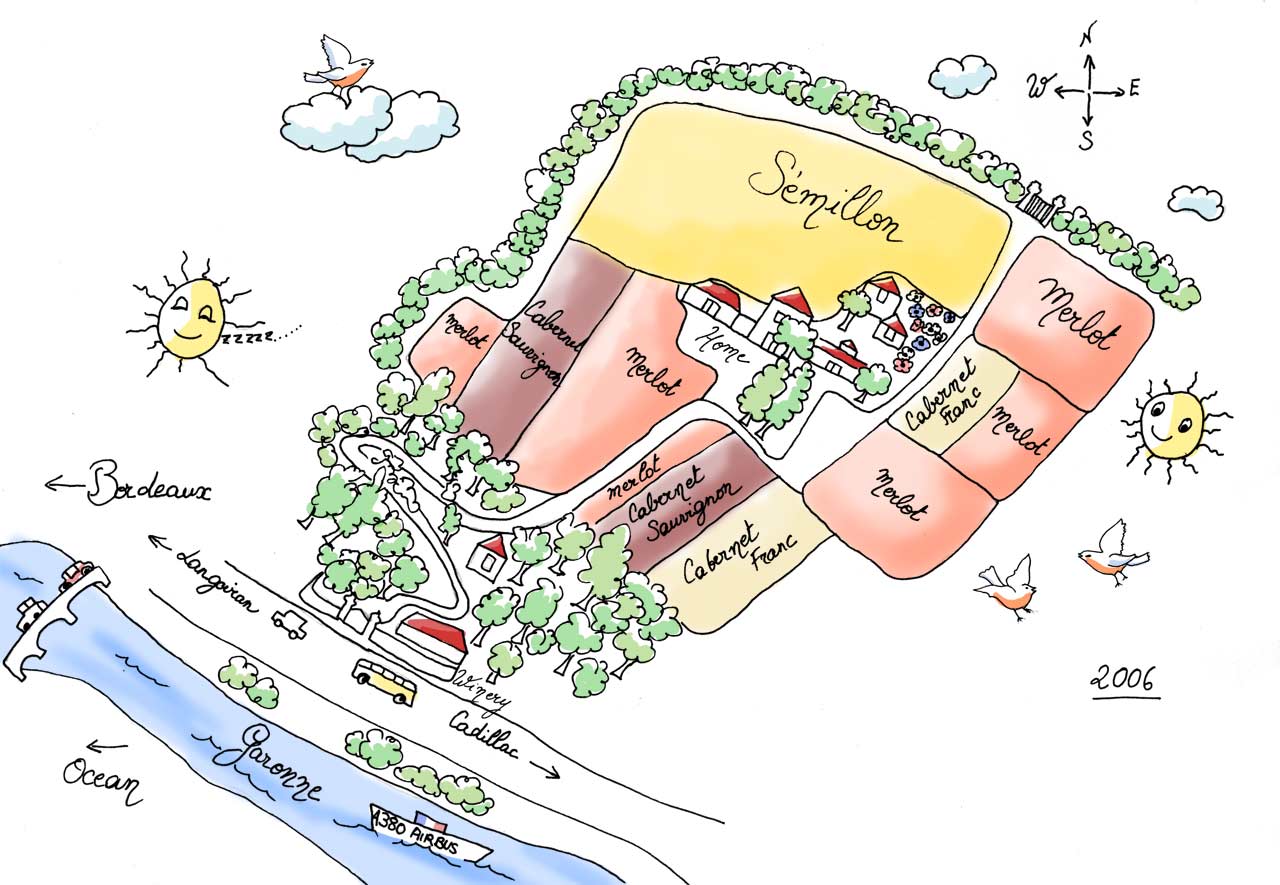
From 2006 to 2014, important changes were made to the vineyard: deep analysis of its soil by Gilles Rey, our agricultural consultant, revealed its extraodinary diversity on a mere 9.7 hectares.
2022
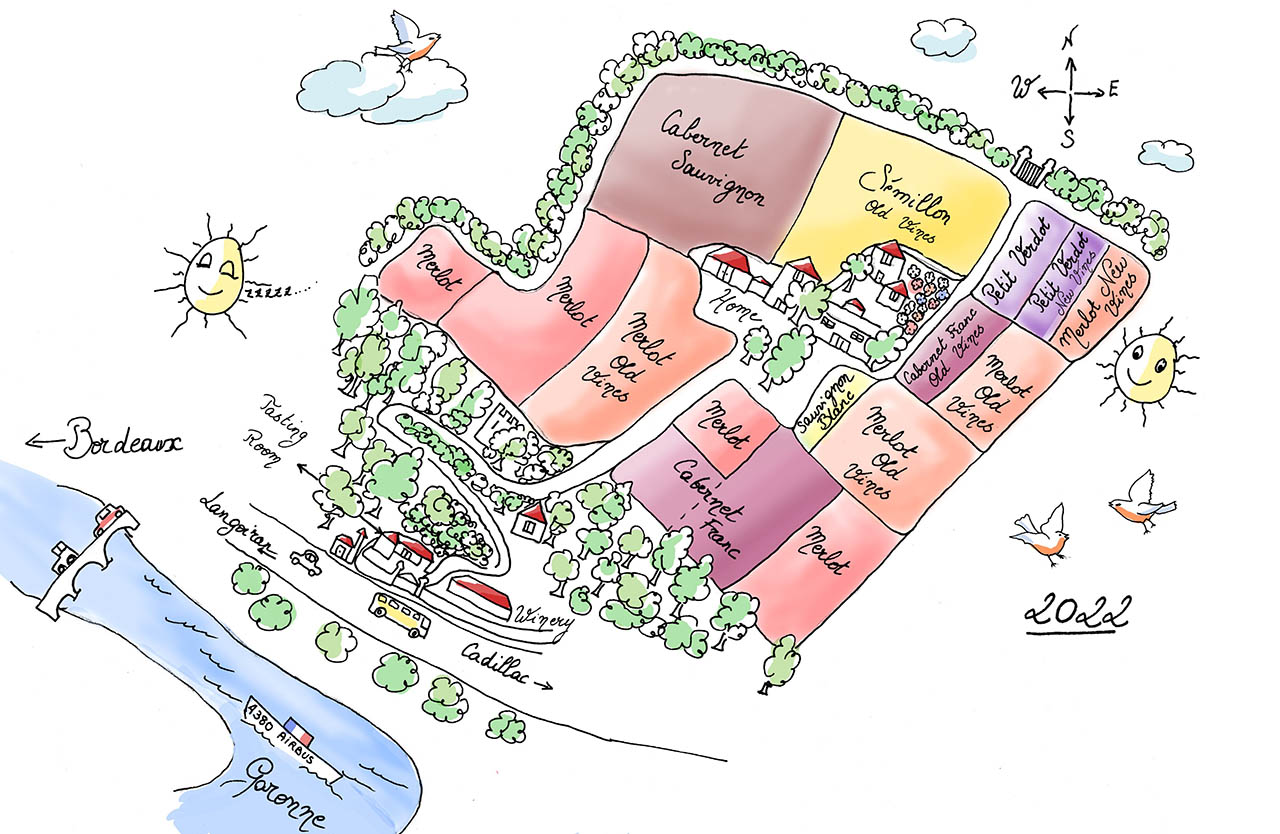
Les Graves (LG1)
Area
- 1.3747 ha
Soil composition
- Top part: 100% gravel
- Bottom part: clay with high density gravel
Grape Variety
- Cabernet Sauvignon
Rootstock
- Top part: 114
- Bottom part: Riparia
Year of planting
- 2008
Density of vines per ha
- 9.100
Pruning style
- “Guyot double”
Les Graves (LG2)
Area
- 1.07 ha
Soil composition
- Top part: clay with high density gravel
- Bottom part: silty-clay with high density gravel
Grape Variety
- Semillon
Rootstock
- Unknown
Year of planting
- 1960
Density of vines per ha
- 5.000
Pruning style
- "Cot"
Chiquette 1
Area
- 0.2459 ha
Soil composition
- Clay with silt and sand (no gravel)
Grape Variety
- Petit Verdot, “selection massale” (propagating new vine stocks from a source of selected vines for their quality)
Rootstock
- 101-14
Year of planting
- 2008
Density of vines per ha
- 9.100
Pruning style
- “Guyot double”
Romeo
Area
- 0.217 ha
Soil composition
- Clay, silt and sand – no gravel
Grape Variety
- Petit Verdot
Rootstock
- 101-14
Year of planting
- 2022
Density of vines per ha
- 9.100
Pruning style
- “Guyot double”
Juliette
Area
- 0.217 ha
Soil composition
- Silt, clay, sand and medium density gravel
Grape Variety
- Merlot
Rootstock
- 3309
Year of planting
- 2022
Density of vines per ha
- 9.100
Pruning style
- “Guyot double”
Sorbier 2
Area
- 0.6155 ha
Soil composition
- Sand with silty-clay, high density gravel
Grape Variety
- Cabernets Francs
Rootstock
- Unknown
Year of planting
- 1968
Density of vines per ha
- 5.000
Pruning style
- “Guyot double”
Sorbier
Area
- 0.6155 ha
Soil composition
- Sand with silty-clay, high density gravel
Grape Variety
- Merlots Old Vines
Rootstock
- Unknown
Year of planting
- 1968
Density of vines per ha
- 5.000
Pruning style
- “Guyot double”
Garenne
Area
- 0.6013 ha
Soil composition
- Silt with clayey-sand, high density gravel
Grape Variety
- Merlot Old Vines except for 9 rows of Cabernets Francs in the bottom part next to two rows of table grapes!
Rootstock
- Unknown
Year of planting
- 1968
Density of vines per ha
- 5.000
Pruning style
- “Guyot double”
Verger
Area
- 0.1638 ha
Soil composition
- Silt with sand, light density gravel
Grape Variety
- Sauvignon blanc, “selection massale” (propagating new vine stocks from a source of selected vines for their quality)
Rootstock
- Not applicable
Year of planting
- 2009
Density of vines per ha
- 9.100
Pruning style
- “Guyot double”
Noël
Area
- 0.68 ha
Soil composition
- Clayey-chalk, medium density gravel
Grape Variety
- Merlot
Rootstock
- Top part: 3309
- Bottom part: Fercal
Year of planting
- 2012
Density of vines per ha
- 9.100
Pruning style
- “Guyot double”
Gaillard
Area
- Gaillard G1: 0.25 ha planted in “Selection massale” ( propagating new vine stocks from a source of selected vines for their quality )
- Gaillard G2 : 0.43 ha planted with traditional vines
Soil composition
- Top part: silt with clayey-sand
- Bottom part: clayey-chalk, light gravel
Grape Variety
- Cabernets Francs
Rootstock
- Rootstock G1: not applicable for selection massale
- Rootstock G2: 214, 327, 394 Fercal
Year of planting
- 2014
Density of vines per ha
- 9.100
Pruning style
- Guyot double
Cedars
Area
- 0.36
Soil composition
- Clay, silt and sand – no gravel
Grape Variety
- Merlots
Rootstock
- 182/3309
Year of planting
- 2014
Density of vines per ha
- 9.100
Pruning style
- Guyot Double
Grand Journal (GJ2)
Area
- 1.0158 ha
Soil composition
- Top part: silt with clayey-sand, medium density gravel
- Bottom part: clayey chalk, medium density gravel
Grape Variety
- Merlot Old Vines
Rootstock
- Unknown
Year of planting
- 1967
Density of vines per ha
- 5.000
Pruning style
- “Guyot double”
Grand Journal (GJ1)
Area
- 0.717 ha
Soil composition
- Top part: sand with silty-clay, no gravel
- Center part: clay with silty sand , 50% gravel
- Bottom part: clayey-chalk, light density gravel
Grape Variety
- Merlot
Rootstock
- Top part: 3309
- Bottom part: Fercal
Year of planting
- 2011
Density of vines per ha
- 9.100
Pruning style
- “Guyot double”
Fer à cheval
Area
- 0.541 ha
Soil composition
- Top part: clay with silty-sand
- Bottom part: clayey-chalk
- Light gravel all over, more sand towards the bordering woods
Grape Variety
- Merlot
Rootstock
- Top part: 3309
- Bottom part: Fercal
- Towards the woods: Riparia
Year of planting
- 2010
Density of vines per ha
- 9.100
Pruning style
- “Guyot double”
Biac has been described as “Burgundy in Bordeaux”: a cluster of small domains each with its own, well defined soil type and matching grape variety, root stock or clone. Spot the difference between the two maps! Click on each plot to discover the soil and sub soil composition!
To become a winemaker or not?
Imagine waking up in the middle of a vineyard, with the city dust just settling on your shoes, surrounded by thousands of vines and not the faintest (or maybe just a little) idea of what to do next!
We quickly realized that we needed professional help at the highest level and …a lot of energy: the vineyard was tired and the winery needed a thorough rethinking to produce a wine in tune with Biac’s potential and historic reputation.
Very soon after we “landed” in Biac, two of Bordeaux ‘s most respected oenologists confirmed to us that the vineyard had a historical reputation of excellence, and was a hidden gem, left dormant for some time. It could however be revived to produce exceptional wines. To do so, we realized we would need professional help at the highest level and …a lot of energy : the vines were tired and the winery needed a thorough rethinking if we were to produce such a wine.
During the summer of 2007, we met Christine Sourdes, oenologist to Château Guiraud and Château de Myrat, who was instantly seduced by our Semillons (hopefully a little by us too). Thanks to her deep knowledge of the region, Christine was able to steer steadily the first vintage of our Cadillac sweet wine: Secret de Château Biac was born that year.
Our big break for the red wines came during a dinner party arranged by a friend to introduce us to Patrick Léon. A legend in the winemaking world, Patrick Léon had taken a step back from the Bordeaux scene after almost 20 years as technical director of the Mouton Rothschild wine estates (including Opus One in California and Almaviva in Chile).
Patrick’s knowledge of Biac’s unique qualities in the region and his conviction of our determination to see the project through convinced him to be our red wine consultant.
With his long time collaborating agricultural engineer, Gilles Rey who also joined the team, we felt much more confident to face the future! Sadly, Patrick passed away in December 2018 after overseeing 10 red wine vintages. As is often the case in Bordeaux, his son Bertrand had joined Patrick’s consultancy some years back. The transition was therefore a natural and smooth one which coincided with Gabriel, our son, joining us in January 2019 .
An initial restructuring plan of the vineyard was drawn up taking out vines which are tired, low quality or, given their varietal, not suitable for the soil where planted. In order not to lower too dramatically the average age of the vines, its implementation would span 12 years. However, the process continues and eventually the entire vineyard will have been restructured. Deep holes are dug each time to map out soil components thus helping us to determine the most appropriate varietal. rootstocks and clones; extra underground drainage is installed to avoid possible water pockets or soil erosion when strong rains fall, and a policy of high density planting (9100 vines per hectare in 1.10m width between rows) to encourage the roots go deeper where the nutrients are to feed themselves.
Gilles Rey declared he didn’t know of a more diverse range of soils on such a small property in the region. We are still discovering and surprised at the wonders of the Biac terroir as we continue to renovate the vineyard. read more...
The maps on the website show the evolution of the vineyard since we acquired it following the restructuring plan elaborated with Gilles Rey . If you are a keen viticulturist, please click on each plot of the 2022 map, and you will have the identity card of this particular plot.
Simultaneously, work began in earnest on the winery: the old stone walls released from decades of cement covering them up, now house a carefully selected number of small thermo regulated stainless vats of various volumes (17 hl to 90 hl); a little winery was built inside the existing one allowing us to vinify our dry and sweet wines side by side with the red .
A YEAR IN THE VINEYARD
There are very few idle moments on a vineyard…and our consultants make sure we don’t forget it !
Throughout the year, many tasks are undertaken to help the vines mature efficiently during their growing cycle: most interventions are manual (and backbreaking!), others like ploughing or mowing between the rows, require mechanical help from specially equipped tractors or “enjambeurs” . Always in search of precision and excellence, we started in Autumn 2023, a new collaboration with a family owned company called Cheval des Vignes. Their Percheron horses will be helping with certain vineyard works such as “ Cavaillonage / Decavaillonage” which is the action of ploughing soil away and then back onto the foot of the vine to free it from weeds without using weedkillers . The combination of man and horse ensures a more precise work: the driver maintains a speed which allows him to avoid hurting the base of the vine , whilst bringing the hoe as close as possible. Working with those magnificent horses contributes to a lighter footprint on the soils and a more ecological environment. It also demonstrates how tradition and modernity can work side by side.
At Château Biac, our philosophy is to look after the vines as we look after ourselves (hopefully ): many people ask whether we are organic , or bio dynamic; our answer to that is : treat the vines as you would treat yourself: eating well, exercising regularly etc. , minimizes the risk of catching some crippling disease; however, science should be used when one faces a critical illness . We apply the same reasoning to the health of our vineyard: regular ploughing and careful monitoring of what our soil needs in terms of organic amendments, encourages healthy biological soil life (don’t you love worms?) ; this stimulates the immunity of the vines , therefore making them more disease resistant. In order to put this into practice most efficiently, Gilles Rey introduced us to the “Methode Cousinié”, a family company with the longest experience in France in the field of plant nutrition. Sometimes though, the region’s temperamental weather (and the law) dictates the need to protect nature with certain scientific treatments, which we apply sparingly and carefully.
To help you follow our working calendar, we present it to you following the seasons .
Ultimately, the weather remains the one determining factor which we do not control but rules our lives! A good dose of sense of humor and adaptability is therefore a viticulturist’s best friend!
- WINTER
- SPRING
- SUMMER
- AUTUMN
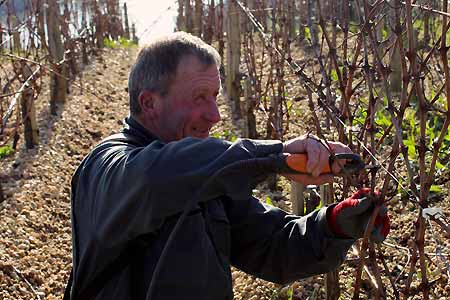
Winter
The working cycle starts in winter: after harvest, once the sap has gone down back into the roots, the leaves fall and pruning can start. It is a long meticulous process which will last all winter. Each varietal requires a careful approach to ensure proper growth for the next vintage.
One last deep ploughing and covering of the vine roots (cavaillonage) with soil for winter protection takes place.
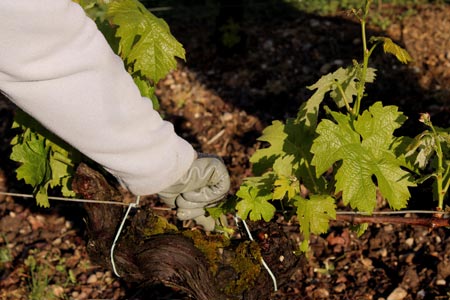
Spring
The pruned vine shoots are collected in bunches or crushed into the soil (some are kept for summer barbecues!). The stems are tied to a wire and the base of the vine is secured to the wooden post. It is then cleared from its winter covering (decavaillonage) and desuckering can begin. Grass mowing and ploughing take place when needed and support wires are raised for the first time to ensure vertical growth of the vines.
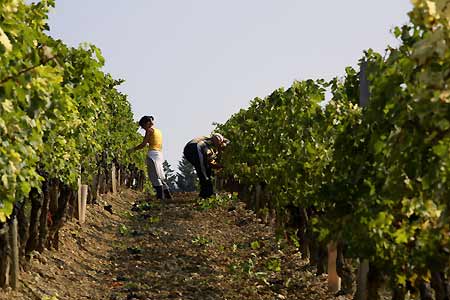
Summer
Further desuckering and lifting of the support wires take place during the month of June quickly followed early July by deleafing on the East side of the vines to allow the summer sun to ripen our grapes. Green harvesting (or crop thinning) will also take place shortly after. Late August, as days get shorter and afternoon sunshine cooler deleafing on the West side of the vines will be carried out to help the ripening process : as we get close to autumnal rains, we also want as much airflow to go through our grapes to protect them from possible rot ; sometimes, depending on the length of time it takes for the “veraison” to happen, a second crop thinning is necessary to ensure homogenous maturity come harvest time. Throughout the summer, capping of the leaf canopy , grass mowing and ploughing continues at regular intervals.
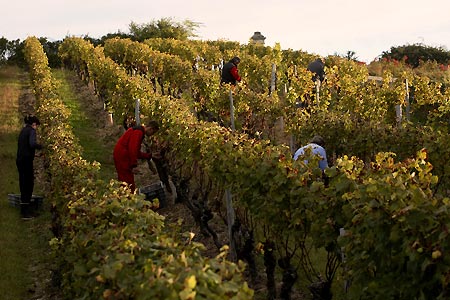
Autumn
Harvest time… At last!
During the weeks prior to harvesting, one can feel a real buzz in the Bordeaux region.
Everyone is watching the weather, washing the vats, cleaning the sorting tables, the harvesting baskets, preparing harvest menus, and holding their breaths: for until the last grape is collected, sorted and eased into the vat, will we be weary of Oceanic capricious weather fronts and how quickly they can destroy one year’s hard labor!
Harvest
This is the time of the year when everything and everyone come together. The time we have all worked for, with different challenges every year in Bordeaux due to the capricious Atlantic weather fronts…
It is also the time of joyful lunches and dinners with our dedicated team! Should you be visiting the area during that time, please join us!
- RED WINE
- SWEET WINE OR "LIQUOREUX"
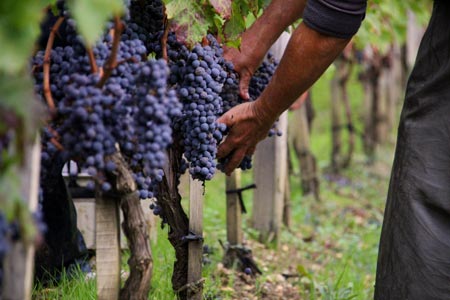
Sorting at the vine…
The green harvesting in the summer has ensured that only the best bunches have remained and have benefited fully from the rich nutrients our soil provides. However, when cutting the bunches, our pickers make sure they are all healthy prior to placing them in small baskets. Any undesired bits are cut off and discarded.
From the vineyard to the winery
The baskets holding no more than 9 kilos of grapes are quickly transported to the winery. A clever system, as shown in the photo, allows the baskets to sit on top of each other without crushing the grapes in the ones below.
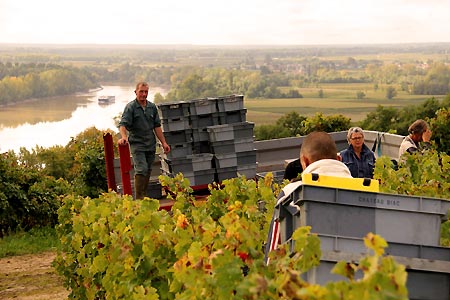
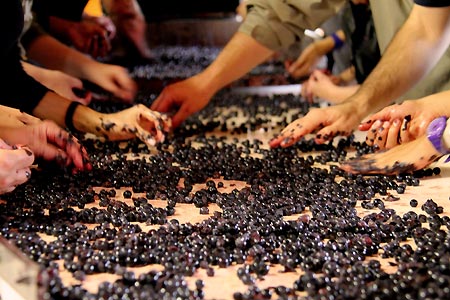
Sorting (again) at the winery
The baskets are trucked at quick, regular intervals to the winery, then carefully emptied one by one onto a vibrating table where members of the home team will check the bunches of grapes once more before they go into the destemming and sorting machine. Finally, the selected berries travel along a conveyor belt where 12 of our most trusted team members make sure that nothing but the best go through to the crusher. They are then directed through a pipe towards the day’s dedicated vat, by natural gravity thanks to the existing incline of our land.
Needless to say that when you spend all this time working together, many secrets are revealed over the table… But the grapes take them to the vats to be drowned in lush, aromatic juice!
Into the vat
The selected grapes will finish their journey by flowing gently through a pipe towards the day’s dedicated vat in the winery, using natural gravity created by the existing natural incline of our property: no pumps, no lifts, just gentle gravity for the grapes to be handled with the utmost care. Another chapter begins….

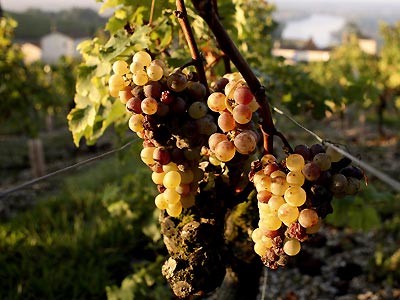
Noble rot (“Botrytis Cinerara”)
Who ever dreamt that a rotten grape complete with hairy fuzz and ugly wrinkles would give birth to the wine of the Gods: liquid gold!
There are many stories of how this came to be, but none has the one claim of veracity!
In a nutshell: the autumnal fog travelling up our hill from the Garonne River gives birth to a fungus: “Botrytis Cinerara” which attacks the grapes and pierces their skin. They shrivel and a layer of hairy fuzz coats them. Then the autumnal sunshine (we hope) comes to the rescue by drying out the rot and the water (by evaporation), thereby concentrating their sugar level. Unexpected aromas of apricot, orange marmalade, white peaches, and pears develop! These are the grapes we will pick. This particular bunch shows several stages of “noble rot” from ready to pick (dark and shriveled) to waiting to rot! (golden)
It is one of the specific characters of Château Biac, that we can produce sweet wines, red wines and dry white wines side by side: another amazing feat of this exceptional “terroir”…
Which rotten grapes?
We pick mostly one grape at a time avoiding injuring the remaining ones. Sometimes, lucky pickers find whole bunches as above! However, sour rot or white rot can also develop: these give vinegar like aromas to the grapes and are to be avoided at all cost: our pickers are chosen for their ability to recognize the good rot from the bad ones! Ultimately, when in doubt, we taste!
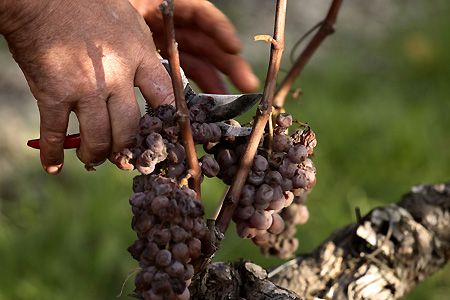
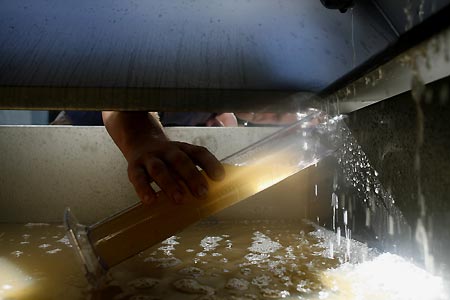
Journey to the winery...
The sweet wine grapes are brought to the winery in their individual baskets. We check them once more before they are carefully placed in a horizontal hydraulic press, programmed to gently extract the juice over several hours.
... And to the barrel
The juice will then spend some time in a vat at a very low temperature before being transferred into new French oak barrels to begin its alcoholic fermentation.
A new vintage is in the making…
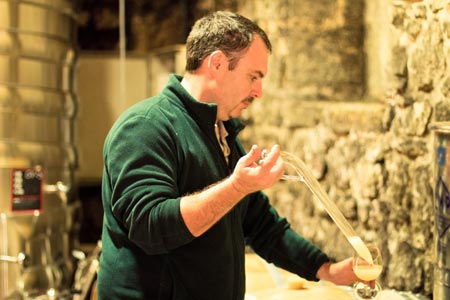
The winery: where it all happens
When we arrived in 2006, the winery had been seriously neglected and was in urgent need of modernization. To produce wines to match our expectations and that of our consultants, it had to be completely rethought. Today the ancient stone walls uncovered during the restoration house the best technology we felt adequate to our team’s requirements, marrying tradition and modernism in pursuit of excellence. Most importantly, a wide range of small thermoregulated stainless vats was selected to hold independently the harvest of each plot or sub plot of the varietals planted : this allows for very precise fine tuning when the time comes to blend our wines.
- RED WINE
- SWEET WINE OR "LIQUOREUX"
- DRY WHITE WINE

Delicious ripened grapes carefully handpicked and sorted, fall by gravity into the vats.

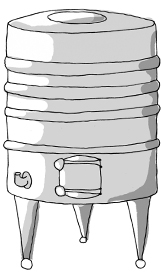
In the dedicated thermoregulated vat, the grapes get to work and convert their sugar into alcohol (alcoholic fermentation); pumping over (remontage) is applied following our teams’ careful tutoring and directions: tannins are softly extracted from the pips and color from the skins. Once this first fermentation is done, the wine (vin de goutte) is transferred to the barrels.

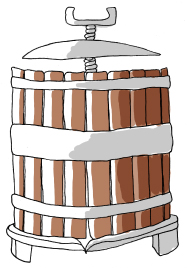
The remaining pulp, pips and skins are then pressed and their juice (“vin de presse”) is set aside in separate barrels. What happens to the “PPS” (pulp, pips and skins)? It is sent to the local distillery! As required by French law!

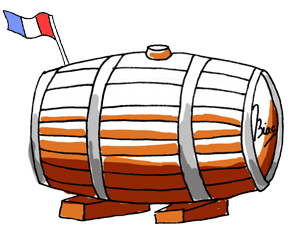
HO2CCH2CHOHCO2H to C3H6O3: Malo-lactic fermentation! Don’t ask! But thanks to this formula, the wine loses its roughness and becomes more palatable; about 40% of our wine will undergo this fermentation in barrels , the rest in the vats.
We use mostly (90%) French oak barrels chosen from a selection of French barrel makers re-assessed every year, the rest being Austro German oak; typically 40-50% new barrels, 40% barrels used once and 10% used twice. During the year, we will hold regular in house tastings with our oenologists and our team to monitor the evolution of our wines in the different barrels.

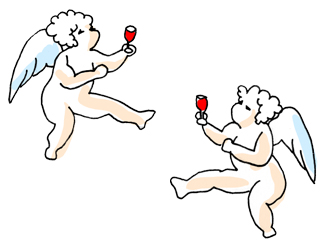
The wine ages approximately 14 to 16 months in the barrels; we try to make sure that the oak does not overpower the fruit, instead, it should enhance the aromas and help the tannins….
Apparently, we are not the only ones tasting our wines …as it evolves during its ageing time in the barrels, we lose about 10% of the initial volume…commonly called “the angel share”: perhaps you can catch a glimpse of them at night….?

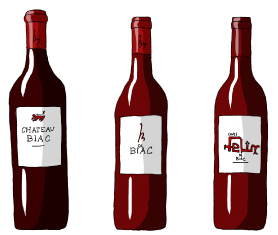
Bottling takes place inside the winery using the services of a very meticulous bottling company. Various bottles sizes are filled with Biac wine ; the bottles are then laid down in our bottle stocking building to rest from the process. they will be released to the market 6 months later …Another journey which began almost two years before in the vineyard, can start…
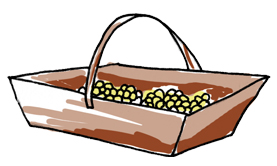
Château Biac has this amazing particularity of being able to produce red, dry white and sweet white wines on a very small terroir


The juice from the selected grapes (usually 100% semillon) is extracted straightaway after picking, but not before they have been checked once more to be properly “ rotten”! and to avoid bad rot which can let out an awful sour smell !
The grapes are pressed in a hydraulic horizontal press (unlike this wooden traditional one!). The pressing time is carefully monitored so as not to shock the grapes , and the juice is extracted gently over several hours..


The juice is then placed into a vat, where overnight, it is maintained at low temperature which precipitates the remaining sediments (or “bourbes”) to the bottom.


The next day, a delicate operation takes place: the clear juice above the sediments must be carefully extracted to be placed in new French oak barrels where it will start its alcoholic fermentation.


Our sweet wine will develop its aromas and age over a period of 14 to 16 months before being bottled. However small the production and depending on the vintage, we feel obliged to let our guardian angels who work so hard looking after the red wine, the ultimate luxury of tasting the sweet wine too!


“Secret de Château Biac” is a tribute to the unique situation of the vineyard. Very few properties if any in Bordeaux, have the ability to make sweet wine from a plot in the midst of red wine making vines on 9.5 hectares only! And so, when the time is right, it is finally bottled alongside its red brother…
Felicie de Chateau Biac
In 2010, seeing how the newly planted Sauvignon Blanc was thriving , Christine Sourdes suggested we pick some of the grapes prior to them being botrytised , enough to make one barrel of dry white wine “just for the house”! the wine soon seduced many of our friends , clients and…our cheeky cat, Felix! thus, Felicie came to life as its sweetheart! …Felicie has now a true following especially that we can only make two or three barrels a year! Another gift from the Biac terroir to be cherished…


Felicie is made from our Sauvignon grapes picked at optimal maturity and prior to the Botrytis getting its grip on them.


Once destemmed, the grapes macerate at low temperature for a period which depends on the vintage.


They are then pressed and the juice is placed in new oak barrels. Fermentation can then begin…


It is bottled after a few months of ageing in the barrel, all the time being racked on the lees.


Felicie is joyful, aromatic, sunny and refreshing ; easily drunk cool all year round..